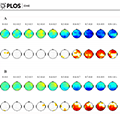Abstract
Facial preference that results from the processing of facial information plays an important role in social interactions as well as the selection of a mate, friend, candidate, or favorite actor. However, it still remains elusive which brain regions are implicated in the neural mechanisms underlying facial preference, and how neural activities in these regions are modulated during the formation of facial preference. In the present study, we investigated the modulation of electroencephalography (EEG) oscillatory power with facial preference. For the reliable assessments of facial preference, we designed a series of passive viewing and active choice tasks. In the former task, twenty-four face stimuli were passively viewed by participants for multiple times in random order. In the latter task, the same stimuli were then evaluated by participants for their facial preference judgments. In both tasks, significant differences between the preferred and non-preferred faces groups were found in alpha band power (8–13 Hz) but not in other frequency bands. The preferred faces generated more decreases in alpha power. During the passive viewing task, significant differences in alpha power between the preferred and non-preferred face groups were observed at the left frontal regions in the early (0.15–0.4 s) period during the 1-s presentation. By contrast, during the active choice task when participants consecutively watched the first and second face for 1 s and then selected the preferred one, an alpha power difference was found for the late (0.65–0.8 s) period over the whole brain during the first face presentation and over the posterior regions during the second face presentation. These results demonstrate that the modulation of alpha activity by facial preference is a top-down process, which requires additional cognitive resources to facilitate information processing of the preferred faces that capture more visual attention than the non-preferred faces.
